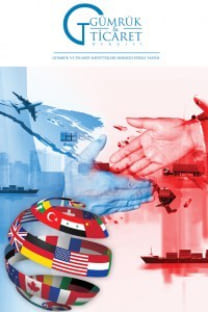Türkiye- Almanya Arasındaki Endüstri İçi Dış Ticaret Yapısının Sektörlere Göre Değerlendirilmesi
Dış ticaret ülkeler için son derece önem arz etmektedir. Ekonomik büyüme, maliyet avantajları ve hazineye gelir sağlanması gibi birçok sebepten ötürü ülkeler birbirleri ile ticaret yapmaktadır. Dış ticaretin bu avantajlarından dolayı çeşitli ticaret teorileri geliştirilmiştir. Klasik ticaret teorilerinde açıklanan ve ekonomi tam istihdamda iken farklı özelliklerdeki ülkelerin ölçeğe göre sabit getiri koşulları altında homojen mallar üretip, bunların ticaretinin yapıldığı ticaret türü endüstriler arası ticaret olarak tanımlanmaktadır. Zamanla benzer özelliklere sahip ülkeler ölçeğe göre sabit getiri koşulları altında farklılaştırılmış malların ticaretini yapmaya başlamıştır. Endüstri içi dış ticaret olarak açıklanan bu ticaret türü klasik ticaret teorileri ile açıklanamamış ve yeni ticaret teorileri ortaya çıkmıştır. Bu çalışmada 2018 yılında Türkiye’nin seçilmiş endüstrilerde en büyük ticaret ortağı olan Almanya ile SITC 78 Kodlu Otomotiv, SITC 84 Hazır Giyim, SITC 67 Demir Çelik, SITC 05 Kodlu Kimya ve SITC 00 Kodlu Gıda alt sektörlerindeki endüstri içi dış ticareti Standart Grubel Llyod Endeksi ile hesaplanmıştır. Seçilen sektörler 2018 yılında Türkiye-Almanya arasında en fazla ticareti yapılan ilk beş sektördür. Buna göre Türkiye ile Almanya arasındaki ticaretin endüstri içi ticaret değil, endüstriler arası ticaret şeklinde olduğu sonucuna varılmıştır.
Anahtar Kelimeler:
Dış Ticaret, Endüstri İçi Ticaret, Türkiye, Almanya
Evaluation of Intra Industry Trade Structure Between Turkey-Germany by Sectors
Countries trade with each other for many reasons such as economic growth, technical progress, cost advantage, and income to the treasury. Because of these advantages, various trade theories have emerged. It is defined as the trade between industries, which is explained by classical trade theories and economically produces full homogeneous goods under fixed income conditions according to the scale of countries with different characteristics while the economy is at full employment level. Countries with similar characteristics over time have started to trade differentiated goods under constant return conditions. The classical trade theories of this type of trade, which are described as intra-industry foreign trade, cannot be explained and new trade theories have emerged. In this study, intra-industry trade calculated by using standard Grubel Lloyd Index for Turkey and its biggest trade partner Germany in 2018 in terms of most traded sectors, SITC 78 Coded Automotive, SITC 84 Clothing, SITC 67 Iron and Steel, SITC 05 Coded Chemistry and SITC 00 Coded food. According to the results, the trade between Turkey and Germany is inter-industry trade rather than intra-industry trade.
Keywords:
Foreign Trade, Intra Industry Trade, Turkey, Germany,
___
- Bano, S. (2013), ‘‘Horizontal, Vertical and Marginal Intra-Industry International Trade and Their Determinants: Evidence For New Zealand And Australia’’, 54 New Zealand Associations Of Economists (Nzae) Annual Conference, 3-5 July 2013. Wellington.
- Brülhart, M. (2002), ‘‘Marginal Intra-Industry Trade: Towards a Measure of Non- Disruptive Trade Expansion’’, P. J. Lloyd and H-H. Lee (der), Frontiers of Research on Intra-Industry Trade (1-26), London: Palgrave-Macmillan, http://www.hec.unil.ch/mbrulhar/papers/gll27.pdf. Erişim Tarihi: 14/04/2017.
- DOĞAKA (2018), Hatay İli Gıda Ürünleri ve İçecek İmalatı Sektör Raporu, 1-73.
- Grubel H.G. and Llyod P.J. (1975), Intra-Industry Trade The Theory and Measurement of International Trade in Differentiated Product, New York: A Halsted Press Book. John Wiley&Sons.
- Handjiski, B., Lucas, R., Martin, P. and Guerin, S.S. (2010), Enhancing Regional Trade Integration in Southwest Europe. World Bank Publications, 185, 1-135.
- Loertscher, R. and Frank, W. (1980), ‘‘Determinants of Intra- Industry Trade: Among Countries and Across Industries’’, Review of World Economics (Weltwirtschaftliches Archive), 116(2), 281-293.
- OSD (2018), Otomotiv Sanayii Dış Ticaret Raporu.
- Özden, A. ve Haçikoğlu, M. (2017), Hazır Giyim Sektörü, A&T Bank Ekonomik Araştırmalar Departmanı, 1-30.
- Pişkin, S. (2017), ‘‘Otomotiv Sektör Raporu: Türkiye Otomotiv Sanayii Rekabet Gücü ve Talep Dinamikleri Perspektifinde 2020 İç Pazar Beklentileri’’, TSKB Ekonomik Araştırmalar, 1-94.
- Pomfret, R. (1987), ‘‘On The Division of Labour and International Trade: or Adam Smith’s Explanation of Intra-Industry Trade’’, Journal of Economic Studies, 13(4), 55-62.
- T.C. Ekonomi Bakanlığı (2016), Kimya Sektörü Raporu.
- TİM (2019), İhracat 2019 Raporu: Yeni Vizyon Yeni Yol Haritası, 1-70.
- TSKB (2018), Sektörel Görünüm: Demir Çelik.
- UİB (2017), Almanya Ülke Raporu (Otomotiv Sektörü Açısından).
- Yayın Aralığı: Yılda 4 Sayı
- Başlangıç: 2013
- Yayıncı: Gümrük ve Ticaret Müfettişleri Derneği
